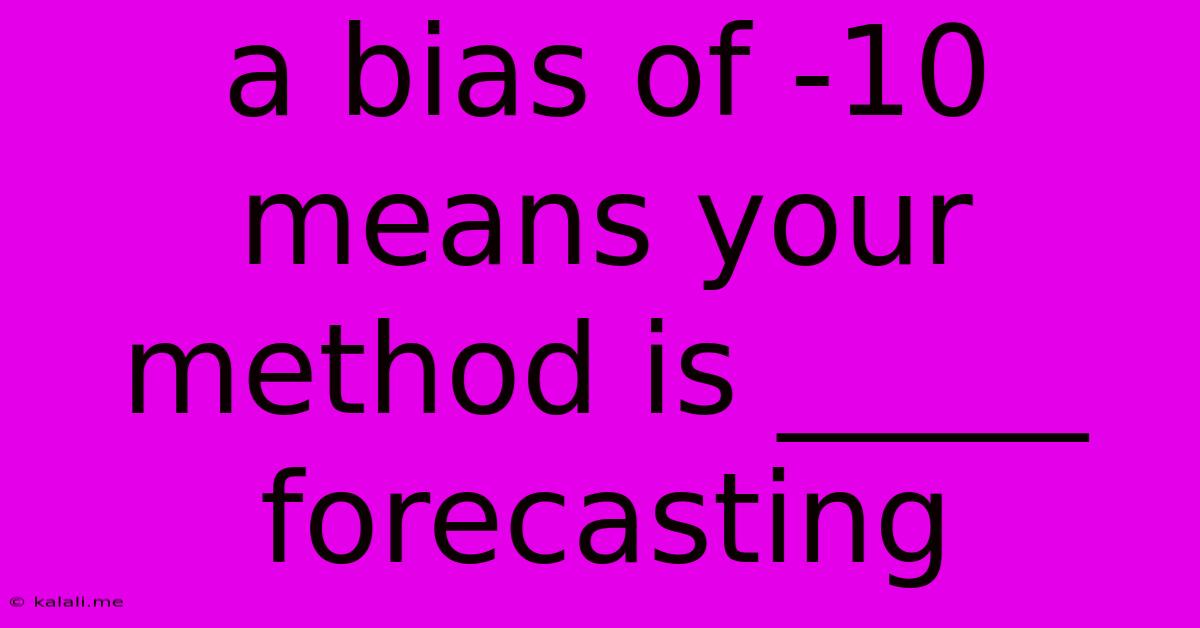A Bias Of -10 Means Your Method Is _____ Forecasting
Kalali
Jun 15, 2025 · 3 min read

Table of Contents
A Bias of -10 Means Your Method is Underforecasting: Understanding Forecasting Bias
A forecasting bias refers to a consistent tendency for a forecasting method to overestimate or underestimate the actual value. Understanding and addressing forecasting bias is crucial for improving the accuracy and reliability of your predictions. This article will explore what a negative bias, specifically a bias of -10, signifies in forecasting and how to interpret and address it.
What does a forecasting bias mean? A forecasting bias indicates a systematic error in your prediction method. It's not about random fluctuations, but a consistent deviation from the actual values. This deviation can be positive (overestimation) or negative (underestimation). A positive bias suggests your method consistently predicts values higher than the actual outcomes. Conversely, a negative bias suggests your method consistently predicts values lower than the actual outcomes.
Interpreting a Bias of -10: A bias of -10 means your forecasting method consistently underestimates the actual values by an average of 10 units. The specific units depend on the variable you're forecasting (e.g., sales in dollars, temperature in degrees Celsius, website visits). This underestimation could stem from various sources within your forecasting model or the data you're using.
Common Causes of Negative Forecasting Bias
Several factors contribute to a negative bias in forecasting. Identifying the root cause is essential for correction. These include:
-
Data issues: Outdated or incomplete datasets can lead to underestimation. Missing crucial data points or relying on data that doesn't accurately reflect current trends can skew your predictions downwards.
-
Model limitations: The forecasting model itself might be unsuitable for the specific data or phenomenon you are trying to predict. A simplistic model might fail to capture complex dynamics, leading to underestimation. Consider exploring more sophisticated models like ARIMA, exponential smoothing, or machine learning techniques depending on your data characteristics.
-
Ignoring external factors: External factors such as seasonal variations, economic fluctuations, or unexpected events (e.g., pandemics, natural disasters) can significantly impact predictions. Failing to account for these factors can lead to consistent underestimation.
-
Underestimating growth or trends: If the underlying trend is upward, and your model fails to capture this adequately, it will likely underestimate future values. This is particularly relevant in scenarios with exponential growth.
Addressing a Negative Bias of -10
Correcting a negative bias involves a systematic approach:
-
Data analysis: Thoroughly examine your data for outliers, missing values, and inaccuracies. Clean and preprocess your data to ensure its quality and reliability. Consider data transformations to address skewed distributions.
-
Model evaluation: Evaluate the appropriateness of your forecasting model. Explore alternative models and compare their performance using metrics such as Mean Absolute Error (MAE), Root Mean Squared Error (RMSE), and Mean Absolute Percentage Error (MAPE).
-
Feature engineering: Enhance your model by incorporating additional relevant variables or features. This might involve adding lagged variables, seasonal indicators, or external factors to capture more complexity.
-
Parameter tuning: Fine-tune the parameters of your chosen model to optimize its performance. This often involves iterative adjustments and testing different parameter combinations.
-
Regular monitoring and updates: Continuously monitor the performance of your model and update it regularly with new data. This ensures that your model remains accurate and adapts to changing trends.
Conclusion: A bias of -10 in forecasting signifies consistent underestimation. This isn't necessarily a catastrophic failure, but rather an indication that improvements are needed. By carefully analyzing your data, evaluating your model, and addressing potential shortcomings, you can significantly improve the accuracy of your forecasts and make more informed decisions. Remember that consistent monitoring and model refinement are crucial for long-term accuracy.
Latest Posts
Latest Posts
-
Match Each Threat To Internal Validity To The Appropriate Description
Jun 16, 2025
-
Is A Speaker An Input Device
Jun 16, 2025
-
Sound Travels Fastest In Which Medium
Jun 16, 2025
-
2 Elements That Are Liquid At Room Temperature
Jun 16, 2025
-
What Is The Greatest Angle Measure In The Diagram
Jun 16, 2025
Related Post
Thank you for visiting our website which covers about A Bias Of -10 Means Your Method Is _____ Forecasting . We hope the information provided has been useful to you. Feel free to contact us if you have any questions or need further assistance. See you next time and don't miss to bookmark.